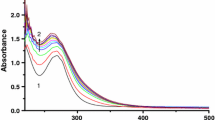Abstract
The presence of anions of phosphate (Pi), pyrophosphate (PPi), adenine nucleotides and sulfate greatly enhanced the production of superoxide radical (·O −2 ) by isolated guinea-pig macrophages. These anions, however, failed to enhance the production of ·O −2 by the xanthine oxidase system, suggesting that they serve only as activators of ·O −2 generating enzyme(s) located on the macrophage cell membrane. Many other common anions were ineffective in the macrophage system. In the presence of concentrations of Pi, PPi, adenine-5′-triphosphate (ATP) reported to be in the synovial fluid, ·O −2 was produced efficiently and was inhibited by diclofenac sodium.
These anions induced rat paw edema, maintained the swelling at least up to 6 h. The edema was suppressed partially by repeated injection of superoxide dismutase (SOD). High doses of sodium chloride and nitrate failed to maintain the swelling.
Similar content being viewed by others
References
Y. Ōyanagui,Inhibitions of Superoxide Anion Productions in Macrophages by Anti-Inflammatory Drugs, Biochem. Pharmac.25, 1473–1480 (1976).
Y. Ōyanagui,Participation of Superoxide Anions at Prostaglandin Phase of Carrageenan Foot-Oedema, Biochem. Pharmac.25, 1465–1472 (1976).
R.G.G. Russell, S. Bisaz, H. Fleisch, H.L.F. Currey, H.M. Rubinstein, A.A. Dietz, I. Boussina, A. Micheli andG. Fallet,Inorganic Pyrophosphate in Plasma, Urine, and Synovial Fluid of Patients with Pyrophosphate Arthropathy (Chondrocalcinosis or Pseudogout). LancetII, 899–902 (1970).
D.J. McCarty andP.F. Pepe,Erythrocyte Neutral Inorganic Pyrophosphatase in Pseudogout, J. Lab. Clin. Med.79, (2), 277–284 (1972).
D.J. McCarty, D.C. Silcox, F. Coe, S. Jacobelli, E. Reiss, H. Genant andM. Ellman,Diseases Associated with Calcium Pyrophosphate Dihydrate Crystal Deposition-A Controlled Study, Am. J. Med.56, 704–714 (1974).
D.C. Silcox andD.J. McCarty,Elevated Inorganic Pyrophosphate Concentrations in Synovial Fluids in Osteoarthritis and Pseudogout, J. Lab. Clin. Med.83, 518–531 (1974).
K. Tomita, A. Ichikawa andH. Hayashi Effects of Cyclic 3′,5′-Adenosine Monophosphate on Inflammations Induced by Inorganic Pyrophosphate, ATP and Other Phlogistins, Japan J. Pharmacol. Suppl. 8 (1972).
D.A. Willoughby, C.J. Dunn, S. Yamamoto, F. Capasso, D.A. Deporter andJ.P. Giroud,Calcium Pyrophosphate-Induced Pleurisy in Rats: A New Model of Acute Inflammation, Agents and Actions5 (1), 35–38 (1975).
A. Yoshimoto, H. Ito andK. Tomita,Cofactor Requirements of the Enzyme Synthesizing Prostaglandin in Bovine Seminal Vessicles, J. Biochem. (Tokyo)68, 487–499 (1970).
J.T. Curnutte andB.M. Babior,Effects of Anaerobiosis and Inhibitors on ·O −2 Production of Human Granulocytes, Blood45 (6), 851–861 (1975).
M. Camerlain, D.J. McCarty, D.C. Silcox andA. Jung,Inorganic Pyrophosphate Pool Size and Turnover Rate in Arthritic Joints, J. clin. Invest.55, 1373–1381 (1975).
J. Roger undD.A. Kalbhen,Der Adenosintriphosphat-Gehhalt des Knorpels unter dem Einfluss verschiedener Antirheumatica in vitro, Arzneim. Forsch.18, 1512–1516 (1968).
R.T. Briggs, D.B. Drath, M.J. Karnovsky andM.L. Karnovsky,Surface Localization of NADH Oxidase in Polymorphonuclear Leycocytes, J. Cell. Biol.63, 36a (1974).
K. Takanaka andP.J. O'Brien,Mechanism of H 2 O 2 Formation by Leukocytes — Evidence for a Plasma Membrane Location, Arch. Biochem. Biophys.169, 428–435 (1975).
R.L. Tse andP. Phelps,Polymorphonuclear Leukocyte Motility in vivo. V. Release of Chemotactic Activity Following Phagocytosis of Calcium Pyrophosphate Crystals. Diamond Dust and Urate Crystals, J. Lab. Clin. Med.76 (3), 403–415 (1970).
D.S. Howell, O. Muniz, J.C. Pita andJ.E. Enis,Extrusion of Pyrophosphate into Extracellular Media by Osteoarthritic Cartilage Incubates, J. clin. Invest.56, 1473–1480 (1975).
R.M. Bennett, J.R. Lehr andD.J. McCarty,Factors Affecting the Solubility of Calcium Pyrophosphate Dihydrate Crystals, J. clin. Invest.56, 1571–1579 (1975).
P. Needlemann, M.S. Minks andR. Douglas Jr.,Stimulation of Prostaglandin Biosynthesis by Adenine Nucleotides — Profile of Prostaglandin Release by Perfused Organs, Circulation Res.34, 455–460 (1974).
M. Höök, Å. Wasteson andA. Oldberg,A Heparin Sulfate-Degrading Endoglycosidase from Rat Liver Tissue, Bioch. Bioph. Res. Commun.67 (4), 1422–1428 (1975).
P. Ghosh, R.W. Stephens andT.K.F. Taylor,The Inhibition of Synovial Fluid Polysaccharides by Gold Sodium Thiomalate, Med. J. Aust.1 (10), 317 (1975).
J.M. McCord,Free Radicals and Inflammation: Protection of Synovial Fluid by Superoxide Dismutase, Science185, 529–531 (1974).
L.S. Cusbing, W.E. Decker, F.K. Santos andT.L. Schulte,Orgotein Therapy for Inflammation in Horses, Modern Vet. Practice54 (7), 17–21 (1973).
K. Lund-Olesen andK.B. Menander,Orgotein: A New Anti-Inflammatory Metalloprotein Drug: Preliminary Evaluation of Clinical Efficacy and Safety in Degenerative Joint Disease, Current Therapeutic Res.16 (7), 706–717 (1974).
R.J. Flower andG.J. Blackwell The Importance of Phospholipase-A 2 in Prostaglandin Biosynthesis, Biochem. Pharmac.25, 285–291 (1976).
K.-L. Fong, P.B. McCay andJ.L. Poyer,Evidence that Peroxidation of Lysosomal Membranes is Initiated by Hydroxyl Free Radicals Produced during Flavine Enzyme Activity, J. biol. Chem.248 (22), 7792–7797 (1973).
C. Malmsten, M. Hamberg, J. Svenson andB. Samuelsson,Physiological Role of an Endoperoxide in Human Platelets: Hemostatic Defect Due to Platelet Cyclo-Oxygenase Deficiency, Proc. Nat. Acad. Sci. USA72(4), 1446–1450 (1975).
Author information
Authors and Affiliations
Rights and permissions
About this article
Cite this article
Ōyanagui, Y. Role of phosphate, pyrophosphate, adenine nucleotides and sulfate in activating production of the superoxide radical by macrophages, and in formation of rat paw edema. Agents and Actions 7, 125–132 (1977). https://doi.org/10.1007/BF01964910
Received:
Accepted:
Issue Date:
DOI: https://doi.org/10.1007/BF01964910




